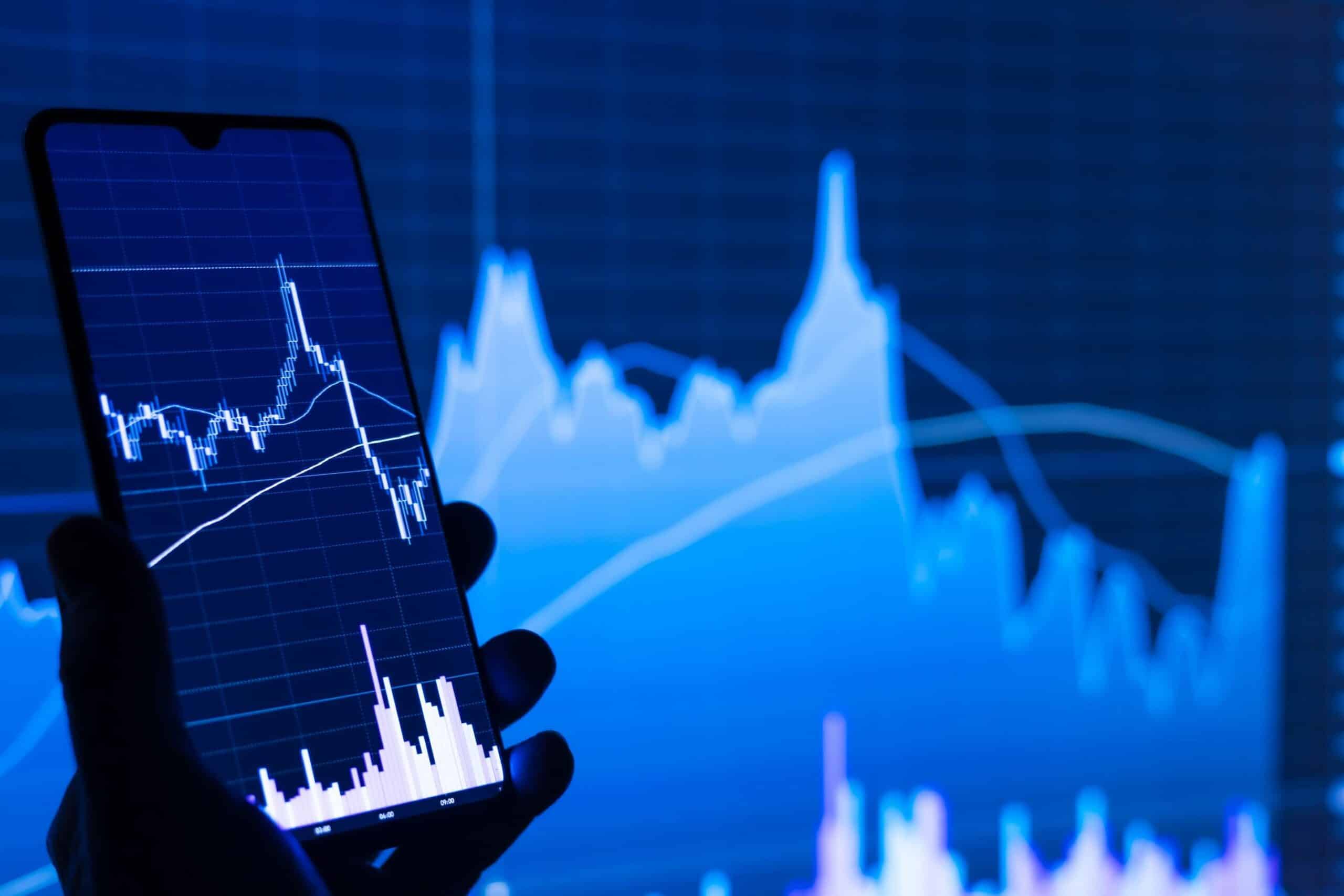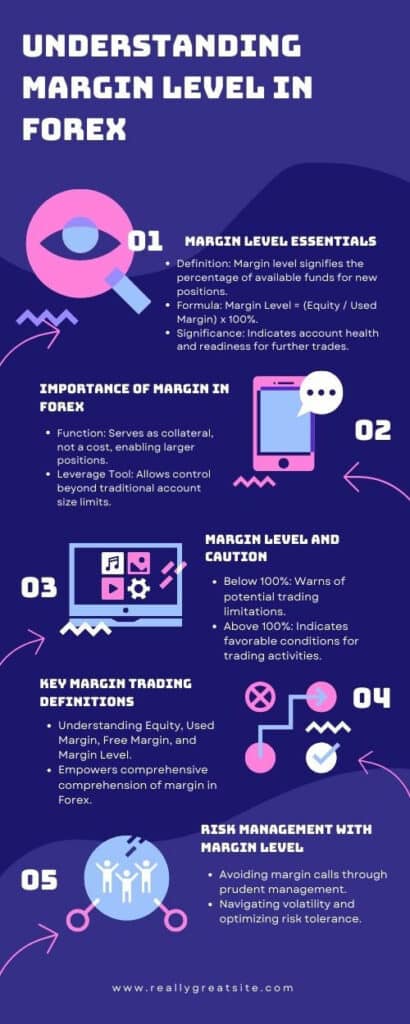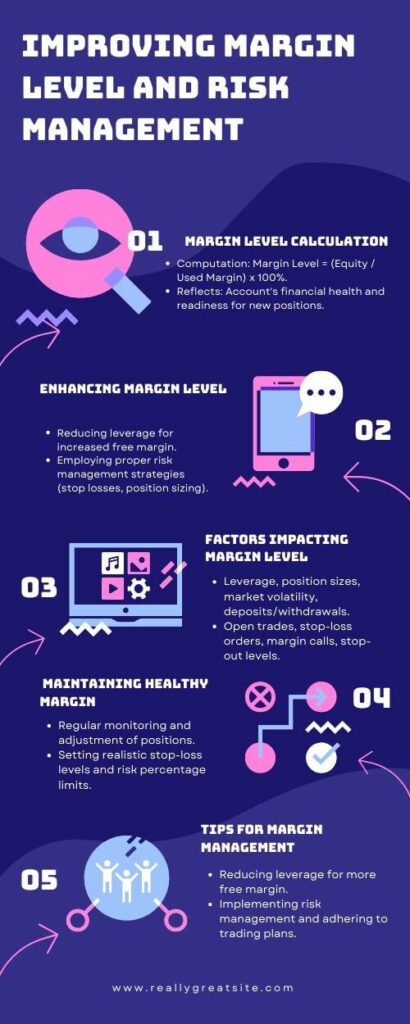
In the thrilling world of forex trading, margin level plays a pivotal role, influencing the scope of your trading endeavors. But what exactly is margin level, and why is it vital for traders? Let’s unravel the essence of margin level and explore its impact on successful forex trading.
Margin level in forex represents the percentage of your available funds that can be allocated to open new positions. Calculated as Margin Level = (Equity / Used Margin) x 100%, it acts as a barometer for your account’s health and readiness for trading activities. A level below 100% may signal caution, while a level above 100% suggests a favorable environment for trading. This blog post will shed light on margin level’s significance and how it can empower traders in the dynamic world of forex.
Key Takeaways
- Margin level is the percentage of available funds in a trader’s account that can be used to open new positions.
- Understanding margin level is essential to avoid margin calls and effectively manage risk in Forex trading.
- Margin acts as a security deposit and allows traders to control larger positions than their account size would normally allow.
- Margin is not a cost, but a collateral that is returned when the position is closed.
- Traders should familiarize themselves with key margin trading definitions such as equity, used margin, free margin, and margin level to have a better understanding of how margin works in Forex trading.
What is Margin Level in Forex?
In the labyrinthine realm of forex trading, one encounters a concept that acts as both guardian and gatekeeper of trading activities – the margin level. This term assumes pivotal importance, as it holds the reins to the available funds one can wield when venturing into the exhilarating world of leveraged positions. To appreciate the nuances of forex trading and safeguard oneself from unwelcome margin calls, a deep understanding of margin level is a prerequisite.
Margin, the Foundation: Before we embark on unraveling the enigma of margin level, it’s essential to revisit the bedrock concept of margin in forex. Margin is akin to a security deposit, a requisite capital shield stipulated by brokers to open leveraged positions. It doesn’t represent a cost but rather serves as collateral that returns to the trader’s coffers once the position is dutifully closed. With margin, traders gain the power to command positions far larger than their account size would traditionally allow, harnessing the leverage to navigate the forex landscape.
The Margin Level: A Precise Compass: Now, let’s dive into the crux of the matter – the margin level. It quantifies the percentage of available funds in a trader’s account earmarked for the opening of fresh positions. To ascertain this level, a prudent consideration of the trader’s equity and the used margin is indispensable. Margin level serves as the compass, offering vital insights into the health of one’s trading account and readiness for new market forays. The calculation is straightforward, represented by the formula: Margin Level = (Equity / Used Margin) x 100%. This numerical index wields the power to either flag potential restrictions on further trading or signal a green light for continued trading endeavors. A margin level reading of 100% or less unfurls cautionary banners, suggesting a need for prudence. Conversely, a level surpassing 100% paints an inviting landscape for unhindered trading activities.
In conclusion, margin level is a cornerstone of risk management in the forex domain. To tread this path successfully, traders must not only acquaint themselves with margin level but also forge a camaraderie with its bedfellows – equity, used margin, free margin, and margin level. By grasping these vital components, traders can navigate the tempestuous waters of the forex market, harnessing the potential for reward while steering clear of the treacherous shoals of margin calls.
The Importance of Margin Level in Forex Trading
Margin level plays a crucial role in Forex trading, as it determines the amount of available funds that can be used for opening new positions. Traders need to understand the importance of maintaining a high margin level to continue trading and avoid margin calls. By effectively managing their risk, traders can ensure the longevity of their trading accounts.
Margin level serves as a key risk management tool in Forex trading. It allows traders to assess their exposure in the market and make informed decisions. Maintaining a margin level well above 100% is essential to have sufficient free margin for opening new positions and to avoid the risk of positions being forcibly closed by the broker.
Traders can enhance their understanding of margin level and its management by delving into various factors that influence it within the forex landscape. These factors include leverage, position size, market volatility, deposits and withdrawals, open trades, stop-loss orders, margin calls, stop-out levels, diversification, and personal risk tolerance. Analyzing these factors allows traders to develop effective risk management strategies and maintain a favorable margin level to safeguard their trading endeavors.
By practicing proper risk management techniques, such as setting stop losses and limiting the percentage of equity at risk on each trade, traders can effectively manage their margin level and mitigate potential losses. It is important to understand that margin level is not static and can fluctuate based on market conditions and trading activities. Therefore, traders should continuously monitor and adjust their positions to ensure a healthy margin level.
| Benefits of maintaining a high margin level: |
|---|
| 1. Allows traders to open new positions and take advantage of market opportunities. |
| 2. Reduces the risk of receiving margin calls and potentially losing positions. |
| 3. Provides a cushion for unexpected market volatility. |
Risk Management Strategies to Maintain a Healthy Margin Level:
- Implement proper position sizing: Trade smaller lot sizes and avoid risking more than 2% of the account equity on any single trade.
- Set realistic stop-loss levels: Use stop losses to limit potential losses and protect against adverse market movements.
- Regularly review and adjust positions: Monitor the market and adjust position sizes accordingly to maintain a healthy margin level.
It is crucial for Forex traders to prioritize risk management and maintain a high margin level to ensure the longevity of their trading accounts. By understanding the importance of margin level and implementing effective risk management strategies, traders can navigate the Forex market with confidence and increase their chances of success.

How to Calculate and Improve Margin Level in Forex
Calculating and managing margin level is crucial for Forex traders to ensure they can effectively control their positions and avoid margin calls. By understanding how to calculate margin level and implementing strategies to improve it, traders can maintain a healthy margin level and minimize the risk of forced position closures.
Calculating Margin Level
At its core, margin level in forex is the ratio of a trader’s equity to their used margin, expressed as a percentage. This percentage serves as a vital indicator of a trader’s financial health within the forex market. It essentially reflects the availability of funds for opening new positions. So, when you come across discussions on forex margin level, remember it’s all about that crucial equity-to-used margin ratio.
To calculate margin level, traders need to divide their equity by the used margin and multiply the result by 100. The formula for margin level calculation is as follows:
Margin Level = (Equity / Used Margin) x 100
The equity represents the current account balance plus or minus any profit or loss from open positions. The used margin is the amount of funds that are currently tied up for open trades. By using this formula, traders can determine their margin level as a percentage.
How to Calculate Margin Level in Forex
The formula for computing margin level is simple but carries great weight:
Margin Level = (Equity / Used Margin) x 100%
This equation is at the heart of every trader’s risk management strategy. It tells you how well your account can withstand market fluctuations and additional trades. Keep in mind that your trading platform typically automates this calculation for you, making it easily accessible.
To comprehend the intricacies better, let’s explore a practical example:
Step 1: Required Margin
Suppose you’re eyeing a trade in USD/JPY, and your account balance stands at $1,000. You’re planning to open a position worth 10,000 units, with a margin requirement of 4%. Calculating the required margin is your first step:
Required Margin = Notional Value x Margin Requirement
In this case, it translates to:
Required Margin = $10,000 x 0.04 Required Margin = $400
Step 2: Used Margin
With just one position in play, your used margin mirrors your required margin, which, in this case, is $400.
Step 3: Equity
Now, consider that your position is hovering around the breakeven point, with no floating profits or losses. Calculate your equity as follows:
Equity = Account Balance + Floating Profits/Losses Equity = $1,000 + $0 Equity = $1,000
Step 4: Margin Level
This brings us to the crucial margin level calculation:
Margin Level = (Equity / Used Margin) x 100%
Hence:
Margin Level = ($1,000 / $400) x 100% Margin Level = 250%
With a margin level of 250%, your path is clear for new trades, as you’re well above the 100% threshold.
Improving Margin Level
To improve margin level, traders have several strategies at their disposal. Firstly, reducing leverage can effectively increase the available free margin in the trading account. By trading with smaller lot sizes, the used margin decreases, allowing for a higher margin level.
Additionally, risk management is essential for maintaining a healthy margin level. Traders should not risk more than 2% of their account equity on any single trade. By implementing stop losses and adjusting position sizes based on risk tolerance, traders can effectively manage their exposure and prevent excessive drawdowns.
Furthermore, traders should plan their trades carefully, considering the potential risks and rewards. A well-thought-out trading plan helps maintain discipline and avoids impulsive decisions that can negatively impact margin level. By following these strategies, traders can significantly improve their margin level and reduce the likelihood of margin calls.
| Strategies to Calculate and Improve Margin Level | Benefits |
|---|---|
| Calculating margin level using the equity and used margin formula | Provides a clear understanding of the current margin level |
| Reducing leverage and trading smaller lot sizes | Increases available free margin and improves margin level |
| Implementing risk management techniques | Ensures controlled exposure and prevents excessive losses |
| Planning trades and following a trading plan | Helps maintain discipline and avoids impulsive decisions |
Margin Level and Risk Management in Forex
Margin level in Forex trading is a crucial factor that directly affects risk management. It is a measure of the available funds in a trader’s account versus the used margin, and it represents the trader’s ability to open new positions. Understanding and maintaining an appropriate margin level is essential to avoid margin calls and protect one’s trading account.
When the margin level falls below a certain threshold, typically 100%, it can lead to a margin call. A margin call occurs when the equity in the account becomes insufficient to cover the used margin, and the broker may forcibly close positions to restore the required margin. To maintain a healthy margin level and mitigate the risk of margin calls, traders should aim to keep their margin level well above 100%.
To effectively manage margin level and reduce the risk of receiving margin calls, traders should implement proper risk management techniques. Setting stop losses is crucial to limit potential losses and protect account equity. By strategically placing stop losses, traders can define their acceptable level of risk for each trade and ensure that losses are minimized.
Proper risk management is the key to maintaining a healthy margin level and protecting your trading account. Implementing risk management techniques like setting stop losses and adhering to risk percentage limits can help traders avoid margin calls and sustain their trading activities over the long term.
Additionally, controlling the percentage of equity at risk on each trade is essential. Risking too much of the account equity on a single trade can quickly deplete the available margin and increase the likelihood of margin calls. Traders should consider risking no more than 2% of their account equity on any given trade to maintain a comfortable margin level.
The Forex Margin Level Indicator
The margin level is your guiding light in forex trading. Think of it as a traffic signal. When your margin level is above 100%, you have the “green light” to open new trades. However, if it drops below 100%, you may face “red lights” in the form of margin calls and stop-outs, which are not welcome situations.
Maintaining a Healthy Margin Level
Successful traders often aim for margin levels above 100%, typically targeting a range of 200%-500% to ensure added security. By focusing on effective risk management, consistent monitoring, and understanding the factors that affect margin level, traders can navigate the forex market with confidence and make well-informed decisions.
The Importance of Margin Level in Risk Management
Margin level is directly tied to risk management in Forex trading. It serves as an indicator of the trader’s account health and their ability to withstand market fluctuations. By maintaining a high margin level, traders have a buffer against potential losses and can continue to open new positions confidently.
Traders should monitor their margin level regularly and take appropriate measures to ensure it remains above the required threshold. By implementing effective risk management strategies, such as setting stop losses and limiting risk exposure, traders can maintain a healthy margin level and protect their trading capital.
| Key Points | |
|---|---|
| Margin level refers to the percentage of available funds in a trader’s account that can be used to open new positions. | |
| A low margin level increases the risk of receiving a margin call and having positions forcibly closed by the broker. | |
| Proper risk management techniques, such as setting stop losses and limiting the percentage of equity at risk, are crucial for maintaining a healthy margin level. | |
| Monitor margin level regularly and take appropriate measures to ensure it remains above the required threshold to avoid margin calls. |
The Importance of Margin Level in Forex Trading
Understanding and monitoring your margin level is integral to managing risk in the forex market. Why is it so crucial? It is a reflection of the influence of your currently opened positions on your account. A higher margin level signifies a more substantial amount of trading capital at your disposal, while a lower margin level can signify potential danger, potentially leading to margin calls.
Factors That Impact Margin Level
To effectively manage your margin level, consider these factors:
- Leverage: Leverage is a double-edged sword. It allows you to control larger positions with a small capital but also affects your margin level. Higher leverage can decrease your margin level, thereby increasing the risk of margin calls.
- Position Size: The size of your positions directly impacts the margin required, with larger positions requiring more margin.
- Market Volatility: Volatile markets can quickly deplete your margin level, especially in the face of rapid price movements.
- Deposits and Withdrawals: Your equity and margin level are directly affected by financial transactions, with deposits boosting your margin level and withdrawals reducing it.
- Open Trades: The number and type of open trades collectively influence your margin level.
- Stop-Loss Orders: Implementing appropriate stop-loss levels can protect your margin level from adverse market swings.
- Margin Calls and Stop-Out Levels: Each broker specifies margin call and stop-out levels, which you must be aware of to plan your trading activities effectively.
- Diversification: Diversifying your trading portfolio across different currency pairs can help manage margin level by spreading risk.
- Risk Tolerance: Your risk tolerance determines how much of your trading capital you’re willing to risk per trade.
Margin Level in Forex Trading: Tips and Strategies
In Forex trading, managing margin level is crucial for traders to maintain control over their positions and avoid margin calls. By implementing effective tips and strategies, traders can optimize their margin level and minimize the risk of forced position closures.
Reducing Leverage and Free Margin
One of the key strategies to manage margin level is by reducing leverage. Lower leverage means lower risk exposure and more free margin available in the trading account. By trading with smaller lot sizes, traders can allocate a smaller portion of their account’s equity to each trade, leaving more room for potential losses without reaching critical margin levels.

Risk Management Techniques
Implementing proper risk management techniques is essential for maintaining a healthy margin level. Traders should set stop-loss orders to limit potential losses on each trade and avoid risking more than 2% of their account’s equity. Additionally, adjusting position sizes according to risk tolerance is crucial. By carefully evaluating the potential risk and reward of each trade, traders can optimize their margin level and protect their trading capital.
Planning and Discipline
Successful margin level management also requires careful planning and discipline. Traders should develop a comprehensive trading plan that outlines their risk tolerance, preferred trading strategies, and profit targets. Adhering to the plan and avoiding impulsive trading decisions can help maintain a consistent margin level and improve overall trading performance.
| Tips and Strategies | Description |
|---|---|
| Reduce Leverage | Lowering leverage can decrease risk exposure and increase available free margin. |
| Implement Risk Management | Setting stop losses and limiting the percentage of equity at risk on each trade can protect against excessive losses. |
| Create a Trading Plan | A well-defined trading plan can help maintain discipline and consistency in managing margin level. |
By following these tips and strategies, forex traders can effectively manage their margin level and minimize the risk of receiving margin calls. It is important to remember that disciplined risk management and careful planning are key components of successful trading in the forex market.
Conclusion
The margin level in Forex is a crucial concept that every trader needs to understand in order to effectively manage their risk and avoid margin calls. It represents the percentage of available funds in a trader’s account that can be used to open new positions. Maintaining a high margin level is of utmost importance, as it allows traders to continue trading without the risk of forced position closure by the broker.
By calculating and improving their margin level, traders can ensure the longevity of their trading accounts and increase their chances of success in the Forex market. It is recommended to reduce leverage and leave more free margin available in the account, which can be achieved by trading smaller lot sizes and not risking more than 2% of the account equity on any single trade.
Proper risk management techniques are essential for maintaining a healthy margin level. Traders should plan their trades, use stop losses to limit potential losses, and adjust position sizes according to their risk tolerance. By implementing these strategies, traders can effectively manage their margin level, minimize the risk of receiving margin calls, and navigate the Forex market with confidence and stability.
FAQ
What is margin level in Forex?
Margin level in Forex is the percentage of available funds in a trader’s account that can be used to open new positions.
Why is margin level important in Forex trading?
Maintaining a high margin level is important to continue trading and avoid margin calls. It helps traders manage their risk and exposure in the market.
How do I calculate margin level in Forex?
Margin level in Forex is calculated by dividing the equity by the used margin and multiplying the result by 100.
How can I improve my margin level in Forex?
You can improve your margin level by reducing leverage, trading smaller lot sizes, and not risking more than 2% of your account equity on any single trade.
What is the relationship between margin level and risk management in Forex?
Margin level is closely linked to risk management in Forex trading. A low margin level indicates a higher risk of receiving a margin call.
What are some tips and strategies for managing margin level in Forex trading?
Some tips and strategies for managing margin level include reducing leverage, leaving more free margin in your account, and practicing proper risk management techniques.

















